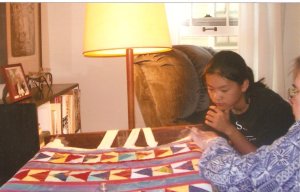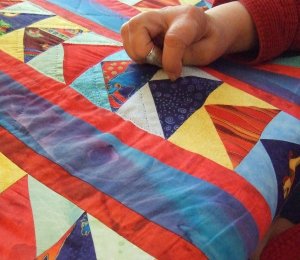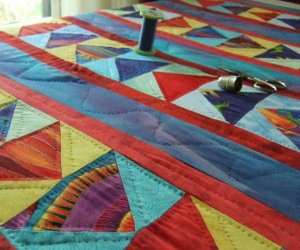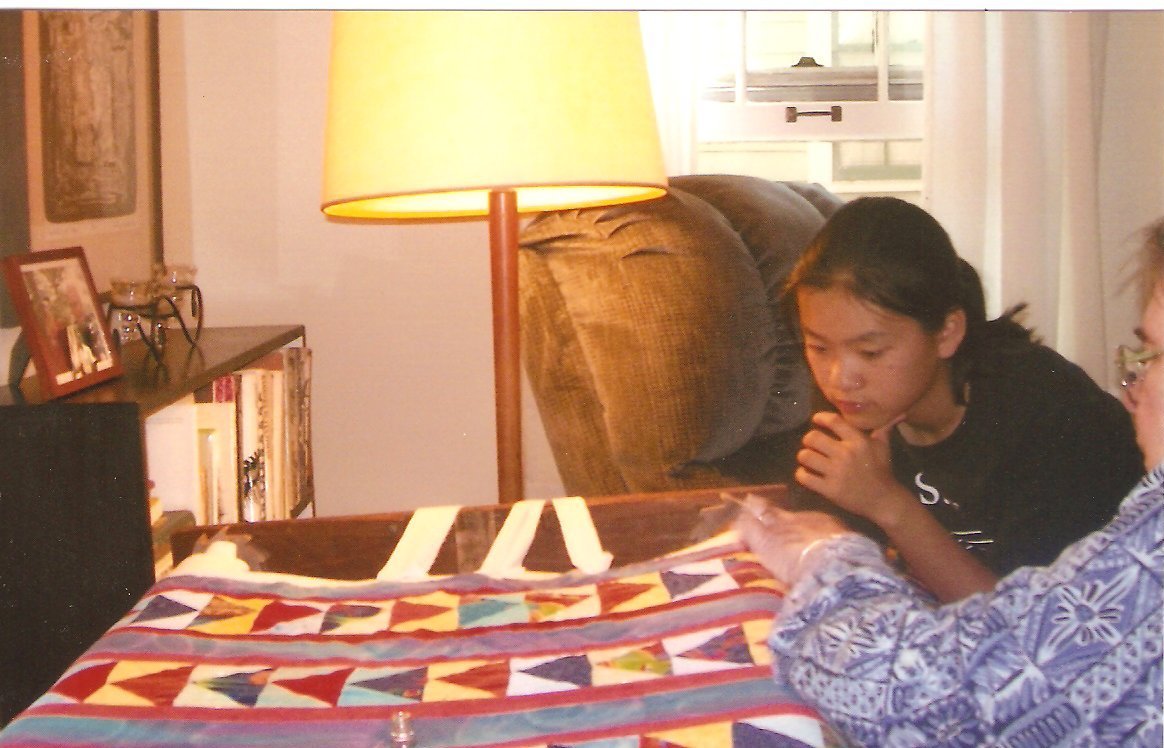Get It Write–not exactly the same as Get It Perfect, is it? I do the very best I can when I know something’s going to see publication and will revise till the cows come home, if I think I’m making it better. Recently, though, I’ve been coming to a whole new understanding of imperfection.
About a year ago, I pieced a new quilt top, the first in years. What turned me on was seeing some great fabrics in the sewing machine repair shop when I took my old Singer for a tune-up. I had no idea what I’d do with them, but they called to me, and I gave in without a struggle. Not incidentally, the quilt I’ve been sleeping under since I finished it 45 years ago was showing signs of needing to retire before I wore it out completely.
I’d made a fair number of quilts and comforters since that one and admired hundreds more in museums and quilt shows and shops. Collected a shelf of quilt books that rivals our local library’s. The first, the Mountain Mist Blue Book (put out by a company that makes quilt batting, the inside layer), taught me what I needed to know to risk starting a craft my two grandmothers enjoyed. One liked piecing tops; the other preferred quilting the layers together. I inherited quilts pieced by Grandma Saulmon and quilted by Grandma Hoskinson. But they’d both died by the time I was learning to talk. So I taught myself by living under their quilts and reading books.
When I started writing mysteries, it was only natural to set one of them in a quilt show. Buried in Quilts has my community orchestra playing an all-American concert in the historic building that houses the show, very much like the one that used to house a real quilt show in Centerville, Indiana. Maybe it still does. I had a lot of fun writing that one. Once was enough for me, though some crafty writers feature quilts in many books. No, I almost forgot Dear Mary Ellen, one of the little books I wrote for adults learning to read. A quilting bee is at the heart of that slightly spooky story about a new bride in her sixties.
Way back when, my mother-in-law gave me what I’m sure is a homemade quilting frame. Or frames–you hear people say both. It’s two long poles and two sawhorse-shaped supports, much lighter than real sawhorses. The poles fit into holes in each support, and wooden ratchets keep them from spinning, so that you can tighten the quilt in the frame once its layers are tacked onto the poles.
Clear as mud if you haven’t seen it, I know. And hard to explain. After all those years of quilting on it, I needed to try explaining how it worked, because the teeth on the ratchet wheels were worn, one almost to nubbins. So I went looking for someone to make me new ones. Took the less worn one as a sample to a woodworker in nearby Brown County. But he was more interested in sculpting a horse out of a log with a chain saw.
 On the way home, I thought of the high school shop teacher. He said sure, and the next day his student produced just the wheels I needed out of some lovely dry walnut he just happened to have lying around. Here they are in action–if you look closely, you can see them. You might even see the flipper things that fit into the teeth, which face in opposite directions to keep the quilt taut, though I’m afraid they’re almost invisible unless you can zoom in. That’s way more than you want to know about them, and as much as I can explain, except to say that they work.
On the way home, I thought of the high school shop teacher. He said sure, and the next day his student produced just the wheels I needed out of some lovely dry walnut he just happened to have lying around. Here they are in action–if you look closely, you can see them. You might even see the flipper things that fit into the teeth, which face in opposite directions to keep the quilt taut, though I’m afraid they’re almost invisible unless you can zoom in. That’s way more than you want to know about them, and as much as I can explain, except to say that they work.
The pattern of the pieced top is called Flying Geese, but it’s my variation on that traditional pattern. I played around with it, and I’m quilting it freehand, not by drawing lines on the fabric. Is it perfect? Not even close. Oh, I keep my stitches as tiny as I can, rocking the needle in my right hand until it touches the brave left forefinger below that signals time to rock up again. It’s a peaceful process, letting my mind wander free to anything I please.
 It’s the peace and freedom that surprised me this time around. I don’t remember feeling so free when I made the one on my bed, maybe because I had little children underfoot back then. Sure, if I notice an ugly stitch in time, I’ll slip it out and do it over. But mostly I relax into the rocking and watch lines of quilting grow, turning the flat surface you see in the first picture, taken when I was just starting to quilt it, into something with texture. It’s hard to stop when I have jobs to do, but this summer I have the freedom to keep on going much of the time. And enjoy it.
It’s the peace and freedom that surprised me this time around. I don’t remember feeling so free when I made the one on my bed, maybe because I had little children underfoot back then. Sure, if I notice an ugly stitch in time, I’ll slip it out and do it over. But mostly I relax into the rocking and watch lines of quilting grow, turning the flat surface you see in the first picture, taken when I was just starting to quilt it, into something with texture. It’s hard to stop when I have jobs to do, but this summer I have the freedom to keep on going much of the time. And enjoy it.
Then one day I heard the voices of both my parents in my head, and I knew why I felt so peaceful. They admired good work, both of them, but they knew how to live with imperfection. My dad played piano, mostly by ear. He used to say, “Anything worth doing is worth doing badly. If you can’t play like Horowitz, play like Hoskinson.”
Mom, a demon knitter, among her other talents, would say about a wrong stitch it was too late to fix, “You’ll never notice it on a galloping mule.”
They were both right. So I relax and keep on rocking and stitching. And the lines, imperfect though they be, keep growing.


Sounds like you quilt for the same reasons I knit–the peace and mental freedom of simple repetitive motions that require just enough attention to stop your mind from fussing. Notice I said fussing, not wandering. Big difference. I love your fabrics and I don’t see a single ugly stitch. Nice post!
LikeLike
Thanks, Nikki. Knitting works for me, too. I like your distinction between fussing and wandering. Exactly what I meant.
LikeLike
Although I don’t quilt myself, I find it very interesting and love the varied, creative patterns. Quilters write excellent mystery novels. Congrats on yours!
Jacqueline Seewald
DEATH LEGACY
THE TRUTH SLEUTH
LikeLike
Thank you!
LikeLike
Nice piece and great illustrations. “Still life with vivid colors and quilting tools.” You may have to rehang your vividly colored Washington painting in the room the quilt ends up in.
Laura K
LikeLike
Funny, Laura! Can’t you just picture that huge painting in my bedroom? The mola that’s there will have to do.
LikeLike
Sara–My grandmother always said, “It won’t be seen from a galloping horse.” For years, whenever I repeated it, my husband and children accused me of making up a silly saying.Now I have vindication. Mule, horse, whatever.
LikeLike
Bev–You tell’em. Mom’s the only person I ever heard use mule in that line, but I know Duke and Kate were the mules she grew up with, so she would.
LikeLike
I think you had very wise parents.
Lovely quilt!
LikeLike
Thank you! It’s so loud, I hope I’ll be able to sleep under it. And you’re right that I was lucky in my parents.
LikeLike
I was right there in your peaceful living room while reading your blog…so nice and quiet.
Thanks Sara
LikeLike
That’s how I feel too.
LikeLike
Beautiful post, Sara. I have a friend who is an avid quilter, and I so admire the skill. Maybe one day I’ll tackle one myself! But I know it would be very imperfect! 🙂
LikeLike
Loved Buried in Quilts, and love quilts–though I’m not a good quilter. Still love the fabrics though. Great blog.
Madeline
LikeLike
Thanks so very much. I had a good time with both of them.
LikeLike
A truly lovely blog and beautifully illustrated, Sara. I love quilts, but am sure I’d be all thumbs at making one! I like your subtle analogy here between doing a perfect job versus an imperfect one that nevertheless brings one pleasure. Just the way I feel about writing books! At least writing one, despite its flaws, gives a sense of a thing well done..
LikeLike
Oh, I hope so!
LikeLike
Loved the post and photos. I’ve only made one quilt (a crazy quilt) and it was FAR from perfect, but I did find the process peaceful and soothing, as you say.
LikeLike
I’ve just spent the last hour or so doing it. Had to fix a place where a seam had pulled apart before I could quilt there, and even that didn’t fuss me too badly. But the mule had better not stroll.
LikeLike
Hi, Sara,
Nice piece! I always enjoyed reading your books that featured quilting. And of course I remember when you were writing those and brought them to the Bloomington writers group years and years ago. I can see that lots of readers out there also like quilts and quilting. But it was your message of learning to live with inevitable imperfection that struck a chord with me. Being a copy editor by profession, my job is to catch all kinds of big and little errors before text makes it into publication. This mind-set became a huge challenge while getting my recent self-published book, which I wrote with a friend and co-author, into print. (Ohio Tales of the Titanic: The Buckeye State’s Fascinating Connections to the World’s Most Famous Shipwreck; see http://ohiotitanic.wordpress.com/ ). Of course I wanted it to be perfect, but, alas, when I got copies of the finished product, it was far from it. I noticed all sorts of things, such as questionable grammar (how did I not notice that???), typos, bad spacing in the text. What would my colleagues think? Here I’m calling myself a professional copy editor but my own book is riddled with minor errors. Well, I’ve corrected a whole bunch of those as we get ready to print more books, having almost sold out of our initial print run of 400, so I’m making it more perfect than it was. I just hate that the book got out there with all of these imperfections, but have had to learn to accept that as part of the self-publishing process. Most readers probably won’t notice these things (I hope, anyway!) and will enjoy the book despite them. Sometimes we have to ease up on ourselves a little and just let it go. You made that point very eloquently! — Mary Ann
LikeLike
Thanks, Mary Ann. Hard to live any other way, really, unless you enjoy beating up on yourself.
LikeLike